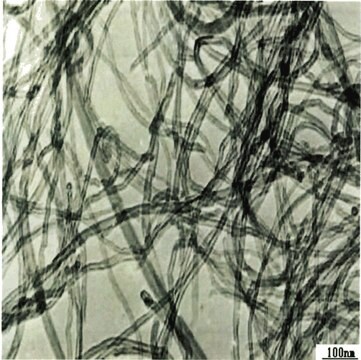773840
Carbon nanotube, multi-walled
≥98% carbon basis, O.D. × I.D. × L 10 nm ± 1 nm × 4.5 nm ± 0.5 nm × 3-~6 μm, TEM, avg. no. of layers, 6 ‑ 8
Sinonimo/i:
SMW200, MWCNT, MWNT, Multiwall carbon nanotube
Autenticatiper visualizzare i prezzi riservati alla tua organizzazione & contrattuali
About This Item
Numero CAS:
Codice UNSPSC:
12352103
Prodotti consigliati
Saggio
≥98% carbon basis
Forma fisica
powder
Caratteristiche
avg. no. of layers 6 ‑ 8
D.E. × D.I. × lungh.
10 nm ± 1 nm × 4.5 nm ± 0.5 nm × 3-~6 μm, TEM
Area superficiale
280-350 m2/g , BET
Punto di fusione
3652-3697 °C (lit.)
Densità
~2.1 g/mL at 25 °C (lit.)
Densità bulk
0.068 g/cm3
Cerchi prodotti simili? Visita Guida al confronto tra prodotti
Descrizione generale
Number of Walls: 6-8 tube walls (typically). Multi walled carbon nanotubes (MWNTs, CNTs) were prepared by chemical vapor deposition (CVD) using cobalt and molybdenum as catalysts (CoMoCAT).In chemical vapor deposition (CVD), a volatile precursor undergoes thermal decomposition at elevated temperatures to form a solid deposit on a substrate. Compared to other techniques CVD produces greater yield of carbon nanotubes. Morphology and structure of the nanotubes can be easily tuned using CVD technique. The CNTs formed can be formed in bundles over a catalyst support or in patterns over substrates.1
Applicazioni
Carbon nanotube, multi-walled (MWNT) belongs to the class of carbonaceous materials with excellent physiochemical, thermo-mechanical and electrochemical properties. This material can be used in a variety of sustainable energy applications such as solar cells, photocatalysis, biosensor, gas sensor, supercapacitor and as a filler that acts as a reinforcement to improve the mechanical property of composites.
New generation of specialty multi-walled carbon nanotubes enable polymer composites with higher conductivity;easier to disperse and mechanical properties for advanced applications like conductive polymers or Li-ion battery cathodes.
Proprietà fisiche
Aspect ratio: > 350-550 (determined by AFM)
Nota sulla preparazione
CoMoCAT™ Catalytic Chemical Vapor Deposition (CVD) Method
Note legali
Product of SouthWest NanoTechnologies;Inc. CoMoCAT® is a Registered Trademark of SouthWest NanoTechnologies;Inc.
SWeNT is a registered trademark of Southwest NanoTechnologies;Inc.
SWeNT is a registered trademark of Southwest NanoTechnologies;Inc.
CoMoCAT is a trademark of Chasm Advanced Materials
Codice della classe di stoccaggio
11 - Combustible Solids
Classe di pericolosità dell'acqua (WGK)
WGK 3
Punto d’infiammabilità (°F)
Not applicable
Punto d’infiammabilità (°C)
Not applicable
Scegli una delle versioni più recenti:
Possiedi già questo prodotto?
I documenti relativi ai prodotti acquistati recentemente sono disponibili nell’Archivio dei documenti.
I clienti hanno visto anche
B. Jin et al.
Electrochemical Communications, 10, 10537-11540 (2008)
K. Sheem et al.
Journal of Power Sources, 158, 1425-1430 (2006)
Olli Pitkänen et al.
Nanotechnology, 31(49), 495403-495403 (2020-09-26)
There is ever increasing demand for flexible energy storage devices due to the development of wearable electronics and other small electronic devices. The electrode flexibility is best provided by a special set of nanomaterials, but the required methodology typically consists
S.K. Martha et al.
Journal of Power Sources, 189, 288-296 (2009)
Claudia Angélica Ramírez-Herrera et al.
Nanomaterials (Basel, Switzerland), 9(2) (2019-02-13)
The demand for multifunctional requirements in aerospace, military, automobile, sports, and energy applications has encouraged the investigation of new composite materials. This study focuses on the development of multiwall carbon nanotube (MWCNT) filled polypropylene composites and carbon nanofiber composite mats.
Il team dei nostri ricercatori vanta grande esperienza in tutte le aree della ricerca quali Life Science, scienza dei materiali, sintesi chimica, cromatografia, discipline analitiche, ecc..
Contatta l'Assistenza Tecnica.




